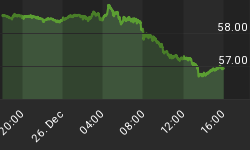In my July 30, 2003 communication I presented evidence that the deep Monthly DJIA Coppock Curve buy signals of 4/28/78 and 5/30/03 are a true pattern pair, not just a pair by default. Now I would like to present evidence that the two signals do form a pattern pair merely by default; that not only are they unlike other true pattern pairs, they are also unlike each other.
The first chart shows the Monthly DJIA Coppock Curve from 10/31/60 to 5/28/04. The colored markers indicate the 8 deep buy signals which occurred within that time span. All 8 signals bear some resemblance to one another, but it is difficult to ascertain any pairing off. A more incisive way of looking at the signals is warranted.

The second chart shows a transformation of the Coppock Curve's month to month change over a similar time span. The transformation consists of plotting the month to month change's 7 month moving average (further smoothed by two 10 month moving averages) against the difference between the month to month change's 3 month moving average and its 10 month moving average (which difference is also further smoothed by two 10 month moving averages). The colored markers represent the 8 deep buy signals.
This transformed Coppock Curve travels counterclockwise, sometimes swinging widely, sometimes curling tightly, and (if visualized in three dimensions) sometimes spiraling down into a central vortex.

The next four charts show, in pairs of signals, the 31 months ending in each of the 8 buy signals.




The 8/31/70 (dark green) and 1/31/75 (red) signals are both preceded by spirals into the vortex. The 4/28/67 (periwinkle) and 10/31/88 (brown) signals are also preceded by spirals into the vortex, but which later flare out to the left. The 1/31/63 (orange) and 8/31/82 (pink) signals are preceded by flat, ordinary loops which manage to skirt the vortex. The 4/28/78 (coral) and 5/30/03 (bright green) signals behave differently from the others and from each other. The 4/28/78 signal is preceded simply by a very wide, flat loop; while the 5/30/03 signal is preceded by a gentle, rather uncertain descent into the vortex.
Meanwhile, as to what happens AFTER each signal, the following 4 charts show, in pairs of signals, the transformed Coppock Curve for the 31 months starting with each of the same 8 signals, except in the case of 5/30/03, which has only 13 observations.




It remains to be seen if the transformed Coppock Curve will unfold, post-5/30/03, in a pattern noticeably similar to that of post-4/28/78.
In light of the above, not only are the 4/28/78 and 5/30/03 buy signals unlike the other three pairs, they are unlike each other. They do not constitute a true pattern pair. If they form a pair at all, it is only by default. This evidence deserves some respect, in my opinion. So, until further notice, I will treat 4/28/78 and 5/30/03 as a pair, but only by default.
In conclusion, this evidence implies that the weak DJIA recovery which followed the 4/28/78 buy signal should not be expected to follow, ipso facto, the 5/30/03 signal. But evidence which does no more than deny the pairing does not necessarily imply an outcome different from what a true pairing would imply. In other words, there could be some other feature of the 5/30/03 signal, such as its hesitancy, which leads ultimately to an outcome similar to 4/28/78's.
PS: Note that I now use 8/31/82 as a buy signal date, rather than 9/30/82 which I erroneously used heretofore.
















